The 5.2MW ammonia heat pump solution will support a district heating network, with a COP of up to 3.34.

Artists impression of the Queens Quay area with the Titan Crane.
Scottish OEM Star Refrigeration has manufactured a 5.2MW (1,479TR) ammonia river-source heat pump solution for a district heating network in Clydebank, west of Glasgow, Scotland.
It is the first industrial scale river-source heat pump for such a purpose in the country, according to Star Refrigeration’s website. The project was a collaboration between Star, Vital Energy and Dunbartonshire Council. It was supported by the Scottish Government’s Low Carbon Infrastructure Investment Programme.
The system consists of two independent heat pumps, each with a capacity up to 2.6MW (739TR), and two 900kW drive motors. The system has a coefficient of performance (COP) of up to 3.34 on full load and 3.07 on two-thirds load, said Dave Pearson, Director of Star Refrigeration, during a presentation at the Institute of Refrigeration (IOR) conference in April. The system efficiency can be tweaked, depending on the water output temperature, Pearson stressed.
According to Pearson, each heat pump has a charge of about 900kg (1,984lbs). He noted that the spray chiller used has a 75% lower charge than that of a shell-and-tube heat exchanger; it is higher than that of a plate heat exchanger, but “plates cannot be automatically cleaned of any fouling that occurs on the river water side.”
The heat pumps were delivered on site at the Queens Quay development in March 2020, and commissioned in November. The system takes water from the river Clyde and uses it to generate the energy needed to heat up the water for the district heating network. The heat pump generates water up to 80°C (176° F) for the 2.5km (8,202ft) piping network, connected to both residential and commercial buildings. The district heating network includes the local town hall, a college and more than 1,000 homes.
The heat pumps are open-loop type, meaning that the water extracted from the river will be in direct contact with the evaporator heat exchanger and associated pipes and valves.
60% lower carbon footprint
The new heat pumps, called a Neatpump by Star Refrigeration, will help the Clydebank council reach its goal of a 15% carbon footprint reduction over the next seven years. The installation has a 60% lower carbon footprint thant a gas boiler, Star said on its website.
The Star Refrigeration design team behind the Neatpump received the Rittinger Award by the International Energy Agency for its work.
The system will also help the council save money due to its ability to use off-peak priced electricity. However, off-peak electricity alone won’t make it a profitable business, as the cost of electricity in the U.K. is five times higher than the cost of gas, according to Pearson, something slowing down the adoption of this environmentally friendly technology, Pearson bemoaned.
Despite this, Star Refrigeration is expecting to see more projects in the coming years. “The parties involved in this project are expecting that other local authorities, wishing to reduce carbon emissions, will be inspired by this proven, low carbon technology,” Star said on its website. There is plenty of scope for repeat projects, with an estimated 6GW of renewable heat available from rivers in England alone, according to Star.
Another incentive for others to repeat the Clydebank project is that the U.K. government has banned gas boilers in neow homes from 2025.
“Providing low carbon heat to the Queens Quay housing development, as well as the college and local businesses, really does put Clydebank at the forefront of renewable energy technology, and it is fantastic to see the interest that is being generated by this exciting project,” said West Dunbartonshire Councilor Iain McLaren. “The scheme looks set to deliver huge environmental benefits, as well as financial ones, far into the future.”
The parties involved in this project are expecting that other local authorities, wishing to reduce carbon emissions, will be inspired by this proven, low carbon technology," - Star Refrigeration
Take a virtual tour of the Clydebank facility here.
Related stories




